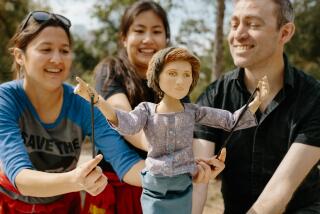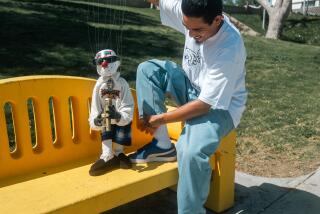CHINA SENDS ITS PUPPETS WITH NO STRINGS
- Share via
It’s nice to know that cultural imports from China have picked up, even to the point of cracking the Orange Curtain.
Consider the latest import, the Peking Puppet Theatre, which made its California debut Wednesday at Saddleback College’s McKinney Theatre in Mission Viejo.
The miniature show with its opera-style vignettes is a thoroughly pleasant and engaging, if innocuous, sampling of traditional Chinese fare. (It plays 8 p.m. today at UCLA’s Center for the Performing Arts, and at 2 p.m. and 7 p.m. Saturday at Pepperdine University’s Smothers Theatre in Malibu.)
A capacity audience of 400 at McKinney Theatre, while not wildly enthusiastic, clearly enjoyed the two hours of musical novelty and technical virtuosity (the bill also included a quietly whimsical turn by illusionist Liu Chen). Other audiences on the 50-city, two-month tour of campuses and community halls in the United States and Canada should find the Peking Puppet Theatre no less intriguing.
After all, they will be treated to an honored form of mass entertainment that in China dates back 2,000 years. “Puppet theater is second only to opera as the most popular entertainment in our country,” explained Wang Huimin, tour director for the Peking Puppet Theatre, one of 100 professional puppet troupes in China. And in China, he noted, puppet productions “are for adults, not only for children, not like it is in your United States.”
The troupe’s 25 members, ages 22-57, all are affiliated with the Chinese Puppet Art Theatre and its school in the Chinese capital. Like other cultural organizations, including those for fine arts and for acrobats, puppet troupes and their schools were “dissolved and dispersed” during the Cultural Revolution of the late 1960s and early 1970s, Wang said.
The Peking Puppet Theatre, since reorganized and again thriving, already has toured Poland, Germany, France, Egypt, Iraq and Japan. This is the troupe’s first tour in North America (although puppeteers from Fujian and Shanghai have already performed in the United States).
Their rod-type puppetry is still based on centuries-old styles that have changed little, even in Communist times.
The puppeteers hoist the wood figures, which are three to five inches tall, with one hand using the large central rod while the other manipulates meticulously wired, connecting sticks. Most characters are manned by one puppeteer, although the larger figures, such as dragons, can take up to four persons.
All this calls for extraordinary finesse by the puppeteers who, out of the audience’s sight, work the figures from below the puppet stage. They achieve lifelike movements, from the most swirling and soaring to the tiniest of nuances, including facial moods.
At the Saddleback College performance, the result was a gentle, wholly charming show--if not an especially riveting one--filled with stock personages from Chinese folk tales and traditional opera.
The show was given only in Mandarin Chinese, so U.S. audiences may miss the niceties of ancient Chinese plots, although the troupe does provide brief English summaries in the program notes and (all-too-few) asides by an English-speaking, off-stage commentator.
But audiences surely can savor the predictably grand, glowing colors of the costumes (exquisitely detailed down to the embroidered sashes and miniature fans), the very broad, opera-style mimicry, and the dainty, swaying damsels in their long-flowing, splendidly hued gowns.
Fortunately, there is also a cast of wonderfully foolish creatures, from plump and inept bureaucrats to snarling, toothy serpents, who are made to waddle, prance, slither and grin with the greatest of ease.
For beguiling simplicity, there was a folk sketch about a nasty encounter between a tortoise and a crane--a duel of slow wits, a pas de deux of escalating comic silliness that was reminiscent of one of those vintage Chuck Jones movie cartoons.
Yet, the best show was probably the one the audience could not see: the show-within-a-show backstage.
There, the puppeteers are worked anonymously in the dark-- moving in minutely choreographed interplay, dancing as their figures danced, jabbing as they jabbed, conjuring astonishing movements with the sweep of the arms.
Or the merest flick of the wrists.
More to Read
The biggest entertainment stories
Get our big stories about Hollywood, film, television, music, arts, culture and more right in your inbox as soon as they publish.
You may occasionally receive promotional content from the Los Angeles Times.










